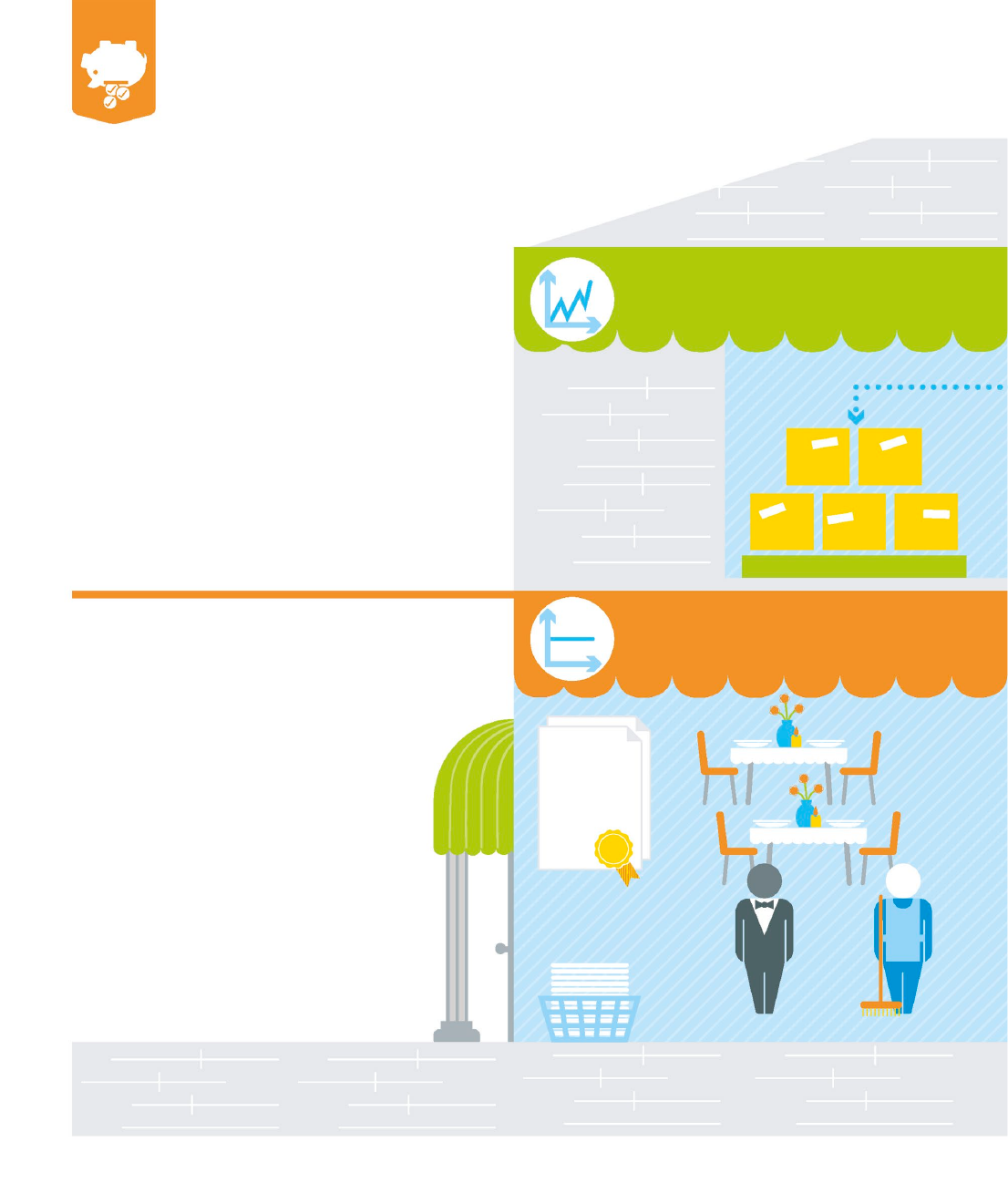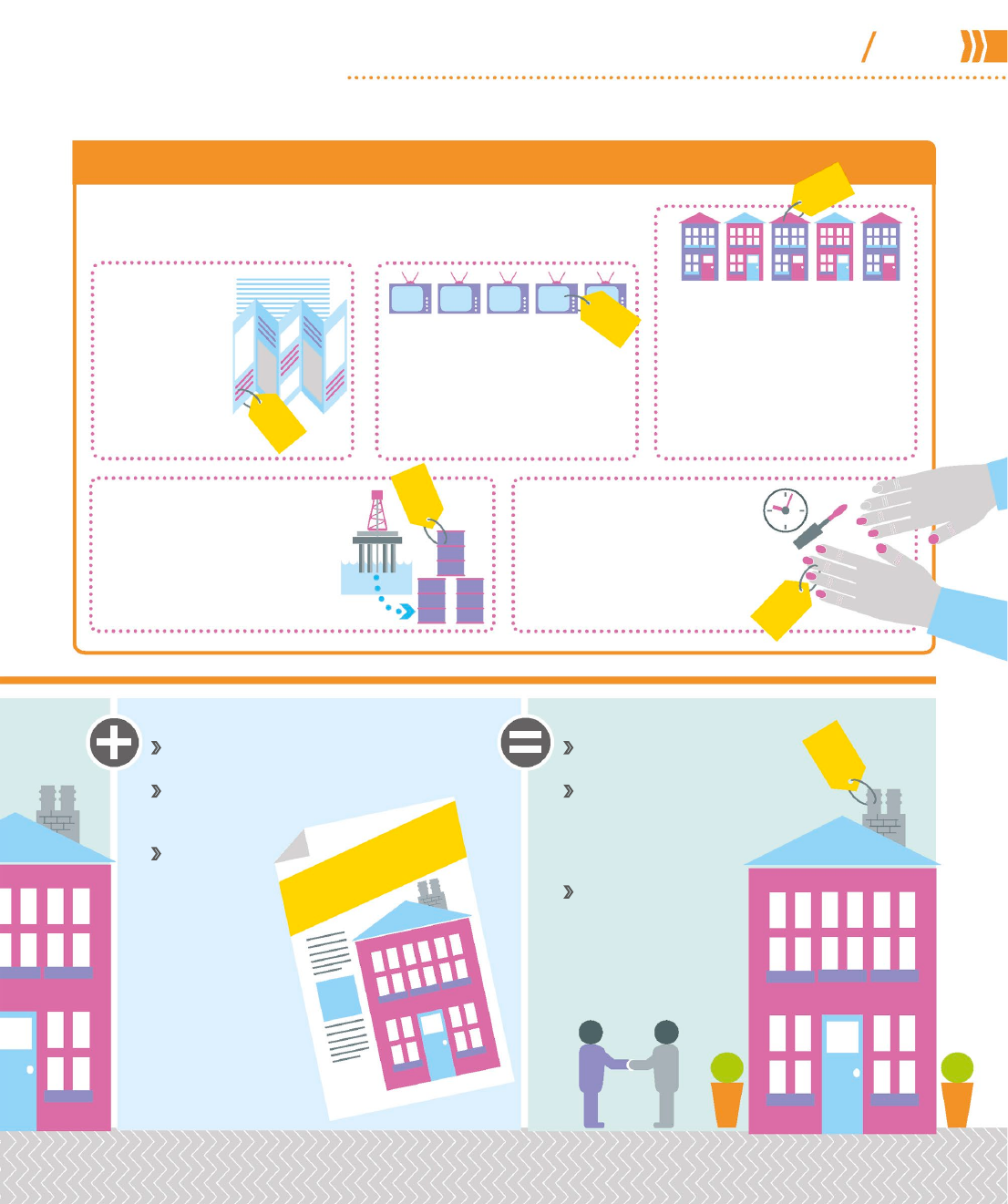
Costs
Fixed and
variable costs
One way of looking at costs is to split them
into two categories: fixed costs, which do not
change with the level of business activity, and
variable costs, which do change with the level
of business activity. This helps accountants
to determine how changes in business
activity (for example, cutting or increasing
production) will affect costs. In reality, some
fixed costs will increase once business activity
reaches a certain level—these are called
stepped fixed costs.
How it works
There are two main ways of classifying costs:
variable costs, which increase as output increases,
and fixed costs, which remain constant; direct and
indirect costs, which contribute directly or indirectly
to the overall running of the business, and can either
vary with the level of production or stay fixed. There
are three main costs that businesses need to account
for. The first is labor—wages paid to people employed
to carry out a particular task. Labor can be regarded
as a direct cost or overhead, or as variable or fixed. The
second is the raw materials used in production and
other materials used in service industries—these costs
are variable. The third is expenses, which are other
costs incurred in the course of the business’s activities.
Costs are the direct or indirect expenses that a business incurs
in order to carry out activities that earn revenue, such as
manufacturing goods or providing a service.
Fixed costs
Variable costs
A restaurant rents premises to cater for 40 diners. The
fixed costs are the same whether the restaurant serves
30 or 40 diners a night.
The head chef orders
the ingredients that will
be required each day.
For peak evenings the
cost of the food order
is higher; for quieter
nights, the food order
is lower.
CLEANING BILL
STAFF SALARIES
LAUNDRY
SERVICES
RENT AND
INSURANCE
COSTS
LARGE
FOOD ORDER
US_140-141_Costs.indd 140 09/11/2016 11:01
140 141
HOW FINANCE WORKS
Management accounting
Break-even point (BEP) The
point at which total sales revenue
is equal to total costs
Questionable costs Costs that
can be treated as fixed or variable
Sunk costs Costs incurred in the
past that cannot be recovered
Prospective costs Costs that
may be incurred in the future
depending on which business
decisions are made
need to know
Stepped fixed costs
The restaurant becomes popular, so the owner rents the
premises next door to serve an additional 40 diners a night.
The costs that were fixed at a certain level have now doubled.
EXTRA
LAUNDRY
SERVICES
HIGHER STAFF COSTS HIGHER CLEANING BILL
HIGHER
RENT AND
INSURANCE
COSTS
PEAK
EVENINGS
QUIETER
EVENINGS
SMALL
FOOD ORDER
40%
of business
owners say that
payroll is their
greatest expense
US_140-141_Costs.indd 141 21/11/2014 16:23

140 141
HOW FINANCE WORKS
Management accounting
Break-even point (BEP) The
point at which total sales revenue
is equal to total costs
Questionable costs Costs that
can be treated as fixed or variable
Sunk costs Costs incurred in the
past that cannot be recovered
Prospective costs Costs that
may be incurred in the future
depending on which business
decisions are made
need to know
Stepped fixed costs
The restaurant becomes popular, so the owner rents the
premises next door to serve an additional 40 diners a night.
The costs that were fixed at a certain level have now doubled.
EXTRA
LAUNDRY
SERVICES
HIGHER STAFF COSTS HIGHER CLEANING BILL
HIGHER
RENT AND
INSURANCE
COSTS
PEAK
EVENINGS
QUIETER
EVENINGS
SMALL
FOOD ORDER
40%
of business
owners say that
payroll is their
greatest expense
US_140-141_Costs.indd 141 21/11/2014 16:23

How it works
Both direct and indirect costs
contribute to the production cost
of a product, whether it is a
manufactured good or a service
being provided. In order to
calculate the cost of a product, it
is treated as one unit of production.
The direct and indirect costs
involved in creating that single
unit are then assessed and added
together to create the full cost.
Product costing
and pricing
Full cost pricing
Direct costs can be measured in terms
of how materials and labor are used
to produce each unit. Indirect costs
(overheads) are harder to assess but also
need to be factored in so that the full cost of
each product can be calculated. Managers
and accountants must apportion indirect
costs to reflect their contribution to the cost
of creating a single product. Once this is
ascertained, the full cost of that product can
be determined. In general terms, the price is
worked out by adding the direct and indirect
costs of production with a
profit margin that gives an
appropriate selling price.
Knowing the full cost of creating each product that a business
sells is vital because it helps a company price its products
appropriately and assess the performance of the business.
Materials
Direct labor
Direct expenses
All used exclusively to
create a product or
service for sale
Direct costs
Production and service
overheads
Administrative
and management
overheads
Sales and distribution
overheads
Share of indirect costs
Absorption costing Allocation
of all production costs to product
Differential costing Difference
between the cost of two options
Incremental (marginal) costing
The change in total costs incurred
when one additional unit is made
Throughput costing Treating all
costs except for direct materials
as period expenses
Cost-plus pricing Product price
is based on direct and indirect
costs, plus markup percentage
NEED TO KNOW
38%
the average total of US
business costs that can be
accounted for by indirect costs
US_142-143_Product_costing.indd 142 09/11/2016 11:01
142 143
how finance works
Management accounting
Share of indirect costs
Profit margin
Selling price
Low: in order to gain market
share, or to match competitors
Cost-based: recover
direct and indirect
costs and profit
margin that the
market will accept
Service-based:
flexible since no
manufacturing or
distribution cost
Must be able to generate profit
for the company
Must be in line with how the
product has been
marketed
Must be
pitched
realistically so
that customers
will buy
Process costing
Used for an ongoing job that often
involves several manufacturing
processes, making it difficult to isolate
individual unit costs—for example,
an oil refinery which processes
crude oil into diesel oil
service costing
Used when the product being sold
is a standard service offered to
customers—for example, a nail salon
offering an express manicure and
pedicure within a set period of time
and for a fixed price
Job costing
Used for a
customized order
made to a client’s
specifications—for
example, a printing
company that
prints brochures
for a client
batch costing
Used when a batch of identical
products is made—for example,
an electrical goods company
manufacturing television sets
contract costing
Used for a large one-time job, often
the result of a tender process (when
a company bids for work) and
carried out at the client’s site—for
example, a construction company
building homes in a new residential
development
$
$
$
$
$
LUXURY HOME
FOR SALE
OTHER COSTING METHODS
There are several different approaches to costing and pricing depending on the
industry, the type and size of the business, and the method of production.
$
US_142-143_Product_costing.indd 143 21/11/2014 16:38

142 143
how finance works
Management accounting
Share of indirect costs
Profit margin
Selling price
Low: in order to gain market
share, or to match competitors
Cost-based: recover
direct and indirect
costs and profit
margin that the
market will accept
Service-based:
flexible since no
manufacturing or
distribution cost
Must be able to generate profit
for the company
Must be in line with how the
product has been
marketed
Must be
pitched
realistically so
that customers
will buy
Process costing
Used for an ongoing job that often
involves several manufacturing
processes, making it difficult to isolate
individual unit costs—for example,
an oil refinery which processes
crude oil into diesel oil
service costing
Used when the product being sold
is a standard service offered to
customers—for example, a nail salon
offering an express manicure and
pedicure within a set period of time
and for a fixed price
Job costing
Used for a
customized order
made to a client’s
specifications—for
example, a printing
company that
prints brochures
for a client
batch costing
Used when a batch of identical
products is made—for example,
an electrical goods company
manufacturing television sets
contract costing
Used for a large one-time job, often
the result of a tender process (when
a company bids for work) and
carried out at the client’s site—for
example, a construction company
building homes in a new residential
development
$
$
$
$
$
LUXURY HOME
FOR SALE
OTHER COSTING METHODS
There are several different approaches to costing and pricing depending on the
industry, the type and size of the business, and the method of production.
$
US_142-143_Product_costing.indd 143 21/11/2014 16:38
..................Content has been hidden....................
You can't read the all page of ebook, please click here login for view all page.
